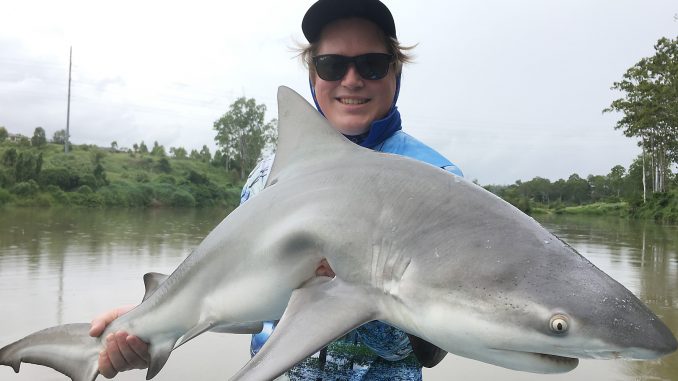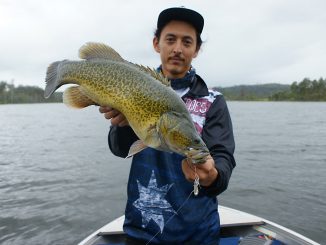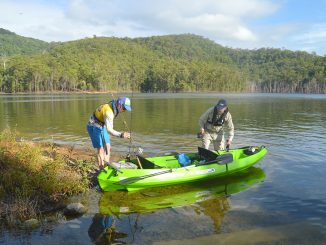
by Bob Thornton •
Summer can be a tough time for anglers in Queensland. There can be weeks of unbearably hot days, followed by periods of cataclysmic downpours that can leave our waterways unfishable.
On top of that, the hot weather can also have the same effect on the fish as it does on humans – sitting motionless out of the sun, trying to get reprieve from the heat. Quite often, the only time predatory fish are active during summer is at periods of low light, which can mean late finishes or super early starts.
There is, however, one sporting target that is readily available along the entire Queensland coast that seems to thrive during the hottest periods of the year.
The humble bull shark, while bearing an undeserved reputation as a killing machine and a menace to our waterways, can actually be great sport during summer. They’re big, they pull hard, they jump, they’re abundant, and they can be caught at any time of the day – what’s not to like? Best of all, with the use of circle hooks, you can release these valuable members of the ecosystem back into the water, and satisfy the compulsion us catch-and-release anglers have.
So how do you find, catch and land these balls of muscle? Let me tell you what I’ve learnt over the years!
ENVIRONMENT
Straight off the bat, this article focuses on targeting the juvenile estuary-going bull sharks, which rarely exceed 1.5m in length, so rivers, creeks and canals are where most of my shark fishing happens. Larger sharks in more open waters require a different approach, and I’ve never done that sort of fishing, so I can’t give advice on it.
After being spawned (bull sharks pups are actually born live, like mammals), the juveniles swim into rivers, creeks and canals to live for a few years, free from predation in an environment that is full of food. As I’ve already stated, these sharks exist all up and down the coast, and anywhere from the mouth of a river or creek system right up to the first impassable barrier, which is sometimes in drinkable freshwater, is likely to house sharks. I’ve seen bull sharks trying to climb rapids, and the next bass I have had taxed by a hungry bully up in the fresh certainly won’t be the last. It’s this tolerance to freshwater that makes these animals so amazing and unique.
RIGGING UP
Most of those who chase bullies have preferences for their rigs, but there are some aspects of a bull shark rig that you simply can’t skimp on. The most obvious is a wire trace – that should be at least 30cm long. I’ve experimented with single strand rigs and premade nylon-coated traces, and haven’t noticed a lot of difference. The wire is important to the rig because a bull shark’s teeth can cut through monofilament of fluorocarbon cheese.
On the bottom of the rig obviously you need a hook, and in the last season I’ve discovered how good circle hooks are for catch and release shark fishing. Anything between a 4/0 and a 10/0 size (depending on the size of the sharks you’re going up against) should suffice. These can either be crimped on when using nylon-coated wire, or attached with a Haywire twist, which you can easily learn from online videos. Some premade rigs also come with the hook already built into the rig.
Above the wire trace, it’s important to have some fairly stiff, abrasion-resistant monofilament or fluorocarbon. Bull sharks, and indeed most members cartilaginous critters, have rough, sandpaper-like bodies that can wear through low-poundage lines, so it’s important to have something there that will stand up. I will usually never go any lower than 40lb, in either mono or fluoro, and even then I occasionally break off on bigger models. Obviously this two-part rig attaches to your mainline.
These are the basics of a shark rig, and optional extras can include various weights, which I will use in strong current, and floats, either foam or biodegradable balloons, which I regularly use to keep my baits away from bottom dwellers like catfish.
On the other end, rods and reels will always be personal. I’ve never felt any need to over gun with heavy boat rods or anything like that, usually opting for lighter, snapper weight gear so I can enjoy the fight. Bullies fight cleanly, and can be knocked over on fairly light gear if you take your time and allow them to run when they want to. I’ve caught plenty of bullies on bass gear, some of them approaching the metre mark, so as long as there’s good terminal tackle on the shark’s end, you should be able to wrestle them to the boat, kayak, or shore you’re standing on.
BAITS
Bully baits vary as much as the imagination, but there are a few standouts the rarely go untouched during a session.
Live baits are a favourite amongst shark anglers, and in Queensland, where cast netting is legal, getting a few decent live baits for a shark session never takes long. I’ve used mullet, herring, gar and pike to catch bullies in the past, and generally speaking you’ll tend to select out bigger sharks when using livies.
The right dead baits can out-fish any live bait if rigged correctly, and anyone who has targeted bullies will know just how effective freshwater eel fillet can be. You can either catch them yourself, or buy them from a tackle store that sells them. They seem to work just as well when defrosted! Who said fresh is best…
Any oily dead bait should work, such as bonito fillets and stingray flaps. I even have a friend who regularly catches them on salami!
METHODS
As a general rule, bullies tend to be hunters, not ambush predators. This means they will be actively searching for prey, and for most sharks, this is round-the-clock work. Because of this, I have found the sharks to be more active when the tide is moving, as a lot of sharks will swim with the current to cover more ground. So when you throw out your bully baits, the idea is for them to come to you. Many times I have observed them on the sounder moving past the anchored boat, and within seconds one or more of the set rods will load up!
Time of day seems to matter little when fishing in rivers and creeks. Although bullies as a general rule will favour periods of low light to hunt, they will hunt all day, even on really hot days. I have a clear memory of sharking on a record 40°C day in a Sunshine Coast creek, and catching a shark mid afternoon!
There’s nothing in particular that I look for when choosing a spot – usually just somewhere I can comfortably anchor the boat or kayak, or that allows me to fish from the bank without the current bringing my bait ashore. A nice outside bend in the river with plenty of current, or a creek or gully mouth will do just fine.
The trick is to let the current take your offering away from the boat, and this way the flowing water will keep the bait away from you and hopefully in the one position.
If you’re fishing with circle hooks, whether under a balloon or on the bottom, it’s important to have a means of feeding line to the bully once it grabs your bait. If you don’t have a baitrunner style reel, you can simply loosen the drag so line can run freely without too much resistance. After allowing the shark to run for 5-10 seconds, it’s just a simple matter of slowly increasing the resistance until the circle hook point gets some purchase in the corner of the shark’s jaw. It’s as simple as that.
If you decide to fish with a fixed float that doesn’t release from the trace when something takes the bait, it’s better to use a ‘j’ style hook. When fishing with this style of rig, it’s important that you hold the rod while waiting for a bite, and strike almost immediately when you see the float disappear under the surface. If you wait too long, the shark will feel the residence of the float and let go.
Sharks won’t always take the bait and move away from you. Sometimes they’ll move off sideways, or cruise back toward you. I’ve had sharks grab my bait, swim under the boat, before pulling tight again on the other side, all while I was having a yarn to my fishing buddy. It’s for this reason that you should always keep your eye on the line and watch for any movement.
TOE TO TOE
Bull sharks always give a good account of themselves, particularly on lighter tackle and, as I touched on earlier, they sometimes jump! Bigger bullies can sometimes take huge surging runs, so having a reel with a relatively smooth drag is a good idea.
Another pro to fishing with light gear is that it tires the shark out before you bring it aboard. If you’ve ever had a large fish come aboard too green, you’ll know what I mean!
When it comes time to land them, it’s important to keep safety as your first priority. A large landing net is always the safest option for landing a bully. If you don’t have one, beaching the animal on the bank is probably the second safest. Although I have tail-grabbed bullies to land them, I don’t recommend landing them in this way, because this leaves the head swinging free and snapping, ready to take a chunk out of an arm or leg.
Long-nosed pliers are a must when sharking, as it allows for a safe hook removal, with your fingers well away from the business end!
If you plan to hold up your bully for a photo, it’s easiest if you grab the tail firmly with one hand, and put another firm hand either under the belly, or around the back of the neck. The latter is better for small sharks. The whole time, I like to point the toothy end well away from my body.
Another tip for shark handling is not to worry about gentle releases, as swimming the shark before release is just another opportunity for something to go very wrong. I usually just spear them straight back into the water like I would with pelagic species. Bullies are hardy and should swim straight off.
EXTRA TIPS
Some shark anglers recommend the use of berley. I don’t typically use berley, but if you want to tip the odds in your favour, it’s fairly easy to concoct your own. Just remember to keep it constant and not to heavy.
Learning how to tie a simple balloon rig (which can be searched for online) will be of great value to you when you set out to target bullies. It can be used with the basic rig I mentioned before, and if you wish to change back to a bottom rig, you can simply remove the balloon from the trace.
It’s fine to keep one for a feed (they have a bag limit of one and a maximum size limit of 1.5m), but I regularly see and hear about individuals who proudly kill these animals needlessly after capture. If you chase sharks simply to kill them, you’re fishing for the wrong reasons. Not only does it make you look bad, it also reflects on the fishing community as a whole. Sportfishing should help to build a respect for a species of fish, and I’m not alone when I say it’s our responsibility to promote the conservation that we practise.
I hope this gives you the boost you need to get out of the house in the middle of summer and load up on a few bullies.
BOBS BEST BULLY BAITS
Live
Mullet
Gar
Herring
Pike
Dead
Freshwater eel
Tuna fillets
Mullet fillets
Stingray flaps
Salami



